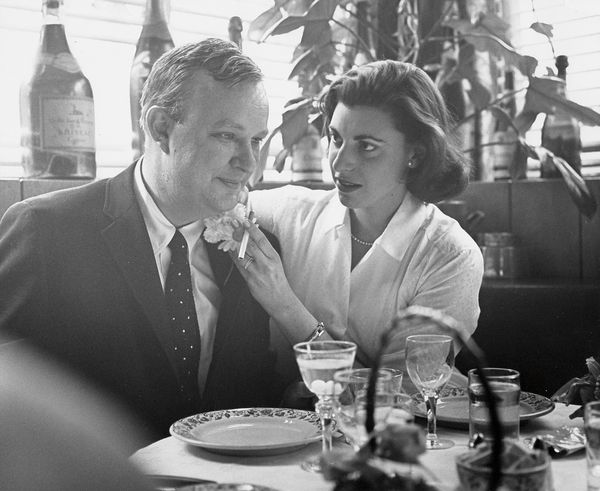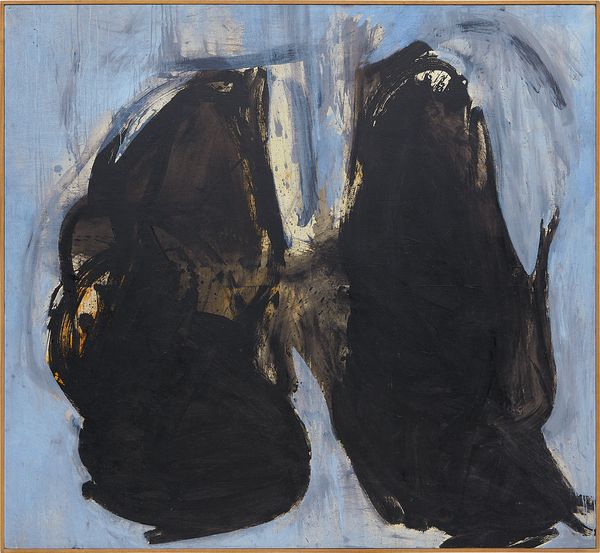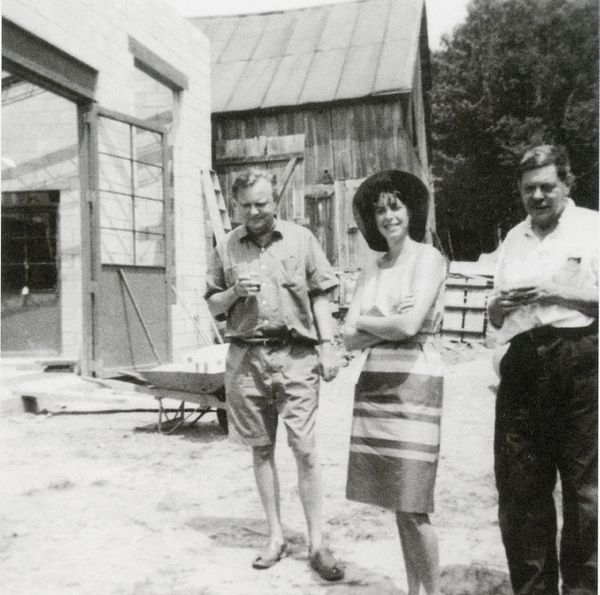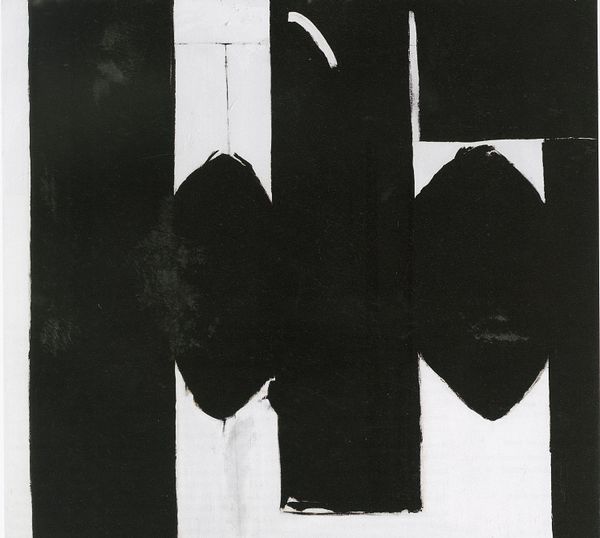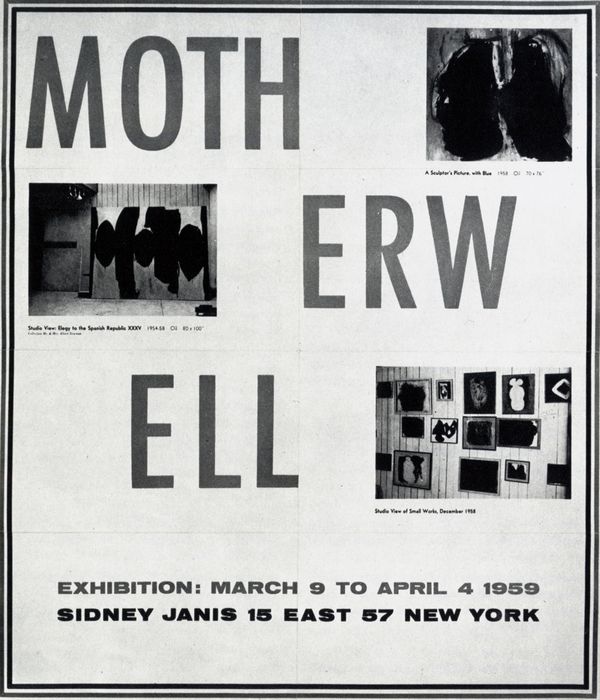Robert Motherwell and Helen Frankenthaler at their wedding lunch, April 6, 1958. Photograph by Hans Namuth courtesy Center for Creative Photography, University of Arizona © 1991 Hans Namuth Estate
Modern art has a different face from the art of the past because it has a somewhat different function for the artist in our time…The need is for felt experience — intense, immediate, direct, subtle, unified, warm, vivid, rhythmic.
— Robert Motherwell
Robert Motherwell's A Sculptor's Picture, With Blue, named after his good friend David Smith, is an absolute tour-de-force from one of the most pivotal years in the Abstract Expressionist's personal life and career.
The monumental painting was created in New York in the spring of 1958 around the time of Motherwell's nuptials to Helen Frankenthaler. Imbued with the sense of figuration so characteristic for Motherwell's abstract compositions, this powerful work visualizes the couple's union with the two black amorphous forms ecstatically merging through the force of splattering brushstrokes.
Robert Motherwell A Sculptor's Picture, with Blue, 1958
In many ways, in its evocation of the light and sea of the Mediterranean landscape, the luminous swathes of blue in the work point to Motherwell's anticipation of the honeymoon in Europe that he would take with Frankenthaler later that summer. He would return to this theme in later years, referencing it in such works as Summertime in Italy No. 8, 1960. A Sculptor's Picture, With Blue represents the culmination of a discrete group of three paintings completed during the joyous period in spring of 1958. As the only work to remain in private hands, its companions now reside in prestigious permanent collections: Afternoon in Barcelona, Whitney Museum of American Art, New York and The Wedding, formerly in the Hirschhorn Museum and Sculpture Garden, Smithsonian Institution, Washington D.C.
Unseen to the public for more than three decades, the work was acquired by Betty Sheinbaum directly from the artist's 1959 solo exhibition at the Sidney Janis Gallery in New York. Remaining in her collection since, Betty loaned the work to major exhibitions at the Pasadena Art Museum, Los Angeles County Museum of Art, San Francisco Museum of Art and the Hirschhorn Museum and Sculpture Garden, Smithsonian Institution, Washington, D.C.
Situated at a crucial turning point in Motherwell's over-five-decade-long career, A Sculptor's Picture, With Blue is testament to the renewed joie-de-vivre, productivity and innovation that the artist's deepening relationship to Helen Frankenthaler ushered in after years of sporadic artistic production and personal struggles. The romantic relationship began in 1957, shortly after Motherwell separated from his second wife Betty Little. Though Frankenthaler was fourteen years his junior, she was already a distinguished painter in her own right, and her confident and energetic presence revitalized him after a period of self-doubt and hopelessness; she notably encouraged him to avoid drinking heavily and to focus on painting again – often sleeping in his New York studio while he worked.
Motherwell began to embrace a more spontaneous and fluid way of working that speaks to Frankenthaler's influence.
Robert Motherwell, Helen Frankenthaler, and David Smith at Bolton Landing, circa 1962
Demonstrating a departure from Motherwell's earlier style, A Sculptor's Picture, With Blue beautifully articulates the unprecedented spontaneity and freedom with which Motherwell began producing new work in 1958. While presenting a continuation of his seminal series Elegies to the Spanish Republic from the past decade and building on the composition of Jour La Maison, Nuit La Rue, 1957-1958, this painting is one of the first works that saw him embrace brighter color hues and looser gestural brushstrokes that cover the canvas with thinned veils of oil paint.
Robert Motherwell Elegy to the Spanish Republic No. 55, 1955–60. The Cleveland Museum of Art, Artwork © Dedalus Foundation, Inc/ Licensed by VAGA, New York, NY
As Lucy Lippard observed in "New York Letter: Miró and Motherwell" from 1965, “there is no doubt that Motherwell has sharpened his color sense, or at least released it, since his marriage, and the openness of his new work may be due either to constant exposure to Frankenthaler's painting or to an increased sense of personal well-being." Working from his East 94th Street studio, Motherwell began to embrace a more spontaneous and fluid way of working that speaks to Frankenthaler's influence. The dynamic process of creation is beautifully articulated in A Sculptor's Picture, With Blue: the rivulets of the thinned pale blue oil paint that run across the underlying composition evidence Motherwell's practice of rotating the canvas, while the black paint splatters function as traces of the expressive, muscular strength with which Motherwell has distilled his inner vision.
This mixture of instinctive free association and willfulness that characterized his pictorial idiom also played into Motherwell's act of naming the work. A salient example of how he typically titled his works as an extension of the painting process itself, the painting was baptized as A Sculptor's Picture, With Blue because, by Motherwell's own account, the great Abstract Expressionist sculptor David Smith loved it so. Smith, who had been friends with both Motherwell and Frankenthaler prior to their relationship, became a regular visitor at the couple's New York residence starting in April 1958 and it was here that he expressed his great admiration for the painting.
As Motherwell fondly recalled his friendship to Smith in 1971, "I enjoyed his companionship more completely than any artist I have ever known; he was literally a member of my family. I have had many close friends among New York artists over the years, but…only David Smith's openness was matched to my own instincts." The fact that A Sculptor's Picture, With Blue combines the explosive energy of American abstraction with two powerful forms that have a sculptural presence must have appealed to Smith, and illustrates a fascinating link between the black forms that are central to Motherwell's most important work from this period such as the Elegy series, and the influence of sculpture, through Motherwell's friendship with David Smith.
Not only does [the painting] offer us a unique snapshot of this remarkable moment in time within the history of Abstract Expressionism, it moreover represents the beginning of Motherwell's mature practice.
Installation view of and poster for Robert Motherwell's exhibition at Sidney Janis Gallery (with the present lot illustrated), 1959. Artwork © Dedalus Foundation, Inc/Licensed by VAGA, New York, NY
Not only does A Sculptor's Picture, With Blue offer us a unique snapshot of this remarkable moment in time within the history of Abstract Expressionism, it moreover represents the beginning of Motherwell's mature practice. In its extreme departure from Motherwell's earlier style, the painting set the stage for Motherwell’s artistic breakthrough immediately thereafter in France in the summer of 1958 that resulted in his famed Iberia series and a powerful resurgence of his Spanish Elegies series.
The singular significance of A Sculptor's Picture, With Blue within this larger body of work from 1958 becomes apparent in its enthusiastic critical reception upon its debut at Motherwell's landmark exhibition at the Sidney Janis Gallery, New York, in 1959. Of all the works on view, this piece was notably celebrated in over four art reviews as the highlight of the exhibition. The New York Times critic Stuart Preston wrote: “A Sculptor's Picture, with Blue is a beauty. Two solid sensuously rounded black shapes, wrapped in mystery and no longer lumpish and inert, float on a cloud of light-color. Their sense of movement and their weightlessness give this picture a monumental buoyancy."
"I think that one's art is one's effort to wed oneself to the universe, to unify oneself through union," Motherwell had explained in 1951, "The need is for felt experience— intense, immediate, direct, subtle, unified, warm, vivid, rhythmic. Created some seven years after that artistic statement, which was quoted in the Museum of Modern Art, New York's exhibiton catalogue from 1965, A Sculptor's Picture, With Blue represents the ultimate embodiment of Motherwell's pursuit of expressing his lived – and importantly felt – within his art.
A jubilant celebration of life, this 1958 canvas powerfully ushered in what would become Motherwell's most celebrated period, painting, as Hjorvardur Harvard Arnason put forward, "with an energy and variety of creative imagination unmatched in any previous period of his career."
